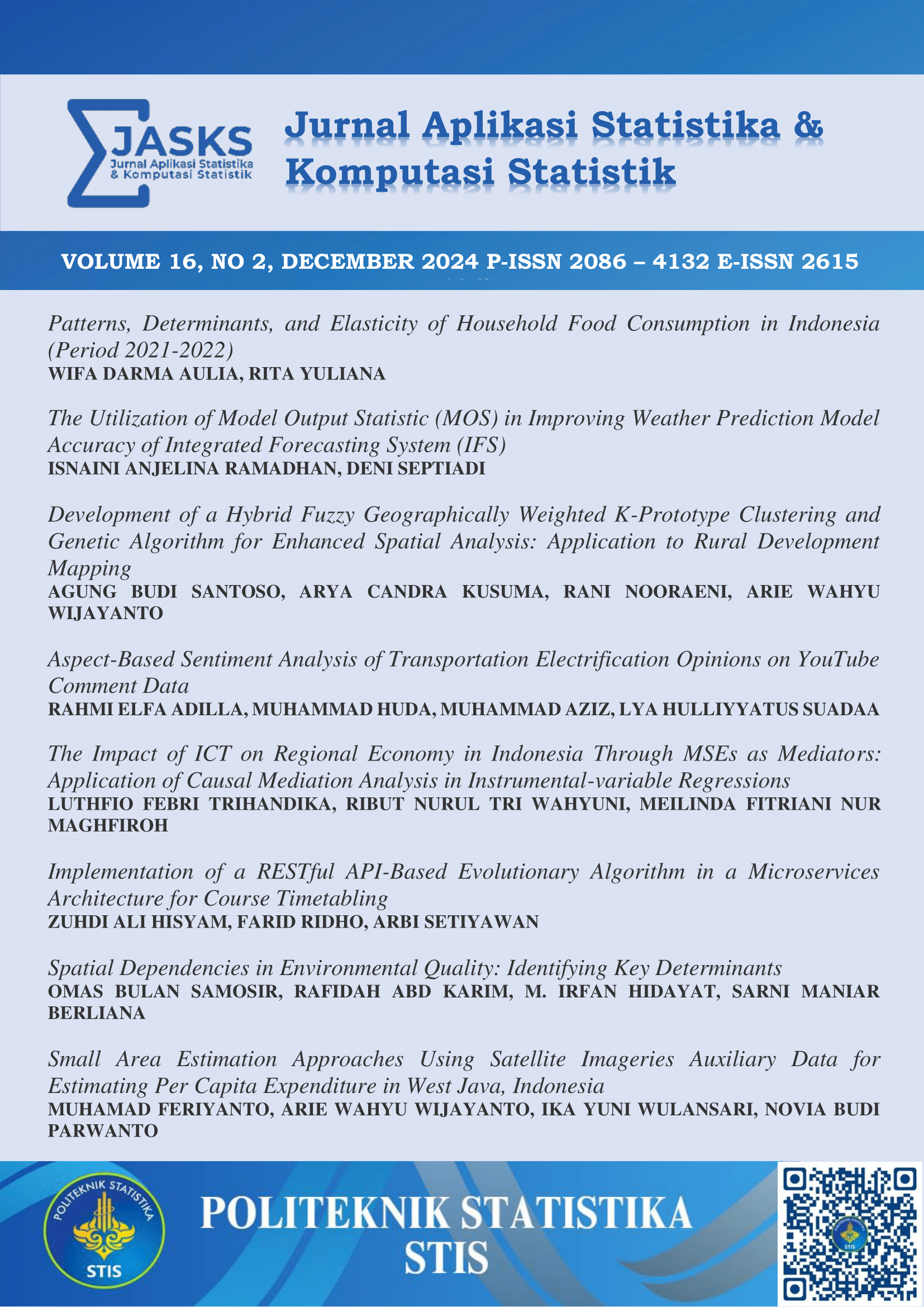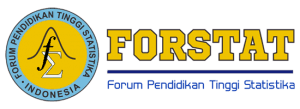Spatial Dependencies in Environmental Quality: Identifying Key Determinants
DOI:
https://doi.org/10.34123/jurnalasks.v16i2.802Keywords:
Natural Environment, Queen Contiguity, Spatial Analysis, Spatial Autoregressive RegressionAbstract
Introduction/Main Objectives: Environmental quality is essential to human development because it reflects the condition of our natural surroundings. Background Problems: Understanding the determinants of environmental quality is crucial for Indonesia as it helps identify the key factors influencing environmental quality. Novelty: This study seeks to identify the determinants of environmental quality in regencies and municipalities on Java Island, incorporating spatial effects into the analysis. Research Methods: The dependent variable is environmental quality index. The independent variables are GRDP in industrial sector, GRDP in agricultural sector, urban population rate, population density, and poverty rate. We applied spatially lag regression model using contiguity spatial weight matrix. Finding/Results: This study shows the spatially lag regression model outperforms the OLS model. GRDP in the industrial sector, GRDP in the agricultural sector, urban population rate, and population density have negative effects, suggesting the increases in these variables were associated with lower environmental quality.
Downloads
References
P. J. Campbell, A. MacKinnon and C. R. Stevens, "The Natural Environment," in An introduction to global studies, West Sussex, United Kingdom, Wiley-Blackwell, 2010, pp. 122-160.
United Nations Environment Programme, "Healthy environment, healthy people," UNEP, 2016.
Department of Economic and Social Affairs, "The 17 Goals," United Nations, [Online]. Available: https://sdgs.un.org/goals. [Accessed 25 August 2024].
Ministry of Environment and Forestry, Regulation of the Minister of Environment and Forestry No. 16 of 2020 about the Strategic Plan 2020-2024, Jakarta: Ministry of Environment and Forestry, 2020.
Ministry of Environment and Forestry, The 2022 Indonesia Environmental Quality Index [Indeks Kualitas Lingkungan Hidup Indonesia 2022], Jakarta: Ministry of Environment and Forestry, 2022.
A. R. Noormalitasari and A. Setyadharma, "Determinants of Environment Quality Index In Indonesia," Efficient: Indonesian Journal of Development Economics, vol. 4, no. 2, pp. 1174-1187, 2021.
P. F. Butarbutar, C. F. Ananda and F. Prasetyia, "The determinants of environmental quality in Indonesia," Journal of Indonesian Applied Economics, vol. 11, no. 1, pp. 27-39, 2023.
US EPA Research, "EPA Researchers Release Updates to Environmental Quality Index," United States Environmental Protection Agency, 18 May 2021. [Online]. Available: https://www.epa.gov/sciencematters/epa-researchers-release-updates-environmental-quality-index. [Accessed 30 August 2024].
M. Wang, N. Arshed, M. Munir, S. F. Rasool and W. Lin, "Investigation of the STIRPAT model of environmental quality: a case of nonlinear quantile panel data analysis," Environment, Development and Sustainability, vol. 23, p. 12217–12232, 2023.
Q. Chen, G. R. Madni and A. A. Shahzad, "The usage of spatial econometric approach to explore the determinants of ecological footprint in BRI countries," PLoS ONE, vol. 18, no. 10, pp. 1-14, 2023.
A. Pujiati, T. Nurbaeti and N. Damayanti, "What are the factors that determine differing levels of environmental quality? Evidence from Java and other islands in Indonesia," Management of Environmental Quality, vol. 34, no. 2, pp. 290-307, 2022.
L. Anselin, "What is Special About Spatial Data? Alternative Perspectives on Spatial Data Analysis," University of California, Santa Barbara, 1989.
F. Wang, Quantitative Methods and Socio-Economic Applications in GIS, New York: CRC Press, 2014.
D. O’Sullivan and D. J. Unwin, Geographic Information Analysis, 2 ed., Hoboken, New Jersey: John Wiley & Sons, 2010.
L. M. Scott and M. V. Janikas, Spatial Statistics in ArcGIS, M. M. Fischer and A. Getis, Eds., Springer-Verlag Berlin Heidelberg, 2010.
J. P. Elhorst, Spatial Econometrics: From Cross-Sectional Data to Spatial Panels, New York: Springer Heidelberg, 2014.
P. A. P. Moran, "Notes on Continuous Stochastic Phenomena," Biometrika, vol. 37, no. 1/2, pp. 17-23, 1950.
M. D. Ward and K. S. Gleditsch, "Location, Location, Location: An MCMC Approach to Modeling the Spatial Context of War and Peace," Political Analysis, vol. 10, no. 3, pp. 244-260, 2002.
J. P. LeSage and M. M. Fischer, "Spatial Econometric Methods for Modeling Origin Destination Flows," SSRN, p. 25, 2008.
J. P. LeSage and R. K. Pace, "Spatial Econometric Models," in Handbook of Applied Spatial Analysis, M. M. Fischer and A. Getis, Eds., Berlin Heidelberg, Springer-Verlag, 2010, pp. 355-376.
D. N. Gujarati, Basic Econometrics, 4 ed., New York: McGraw Hill , 2004.
H. Akaike, "Information theory and an extension of the maximum likelihood principle," in Second International Symposium on Information Theory, Budapest, 1973.
Q. H. Vuong, "Likelihood Ratio Tests for Model Selection and Non-Nested Hypotheses," Econometrica, vol. 57, no. 2, pp. 307-333, 1989.
M. Demiral, Ö. Hayk?r and E. D. Aktekin-Gök, "Environmental pollution effects of economic, financial, and industrial development in OPEC: comparative evidence from the environmental Kuznets curve perspective," Environment, Development and Sustainability, 2023.
C. Karaduman, "The effects of economic globalization and productivity on environmental quality: evidence from newly industrialized countries," Environmental Science and Pollution Research, vol. 29, p. 639–652, 2022.
I. Ummi, Rusdarti and H. Y. , "Relationship of the GRDP Sectors with Environmental Quality Index in Indonesia 2012-2017," Journal of Economic Education, vol. 8, no. 2, pp. 152 - 158, 2019.
S. Saghaian, H. M. and M. Mohammadi, "The Effects of Agricultural Product Exports on Environmental Quality," Sustainability, vol. 14, pp. 1-11, 2022.
H. Lu, Z. Shang, Y. Ruan and L. Jiang, "Study on Urban Expansion and Population Density Changes Based on the Inverse S-Shaped Function," Sustainability, vol. 15, no. 13, pp. 1-19, 2023.
H. Zhang, "The Impact of Urban Sprawl on Environmental Pollution: Empirical Analysis from Large and Medium-Sized Cities of China," International Journal of Environmental Research and Public Health, vol. 18, no. 16, pp. 1-19, 2021.
L. Han, W. Z. W. Li and Y. Qian, "Urbanization strategy and environmental changes: An insight with relationship between population change and fine particulate pollution," Science of The Total Environment, vol. 642, pp. 789-799, 2018.
A. N. Wafiq and Suryanto, "The Impact of Population Density and Economic Growth on Environmental Quality: Study in Indonesia," Jurnal Ekonomi & Studi Pembangunan, vol. 22, no. 2, pp. 301-312, 2021.















